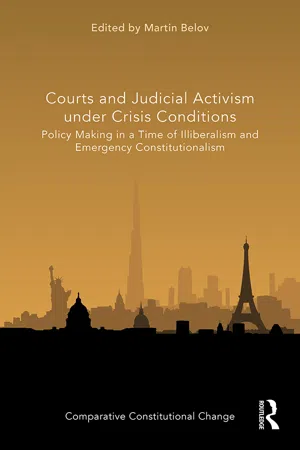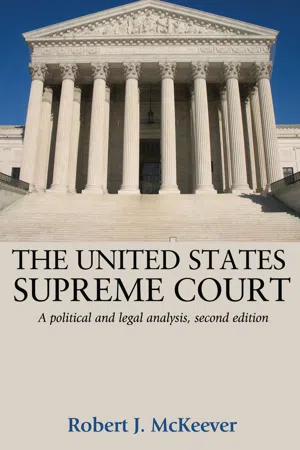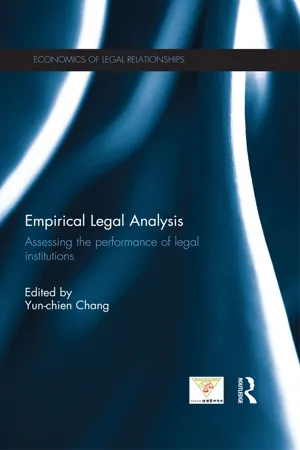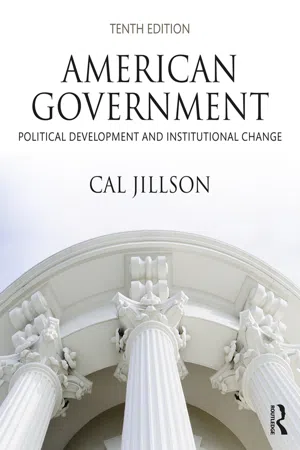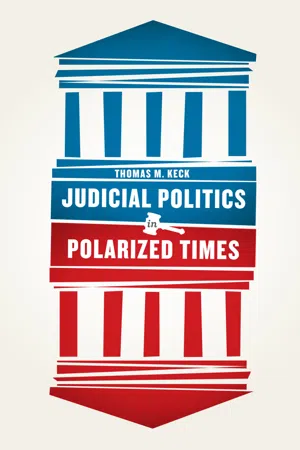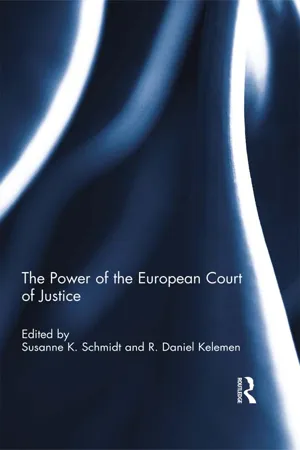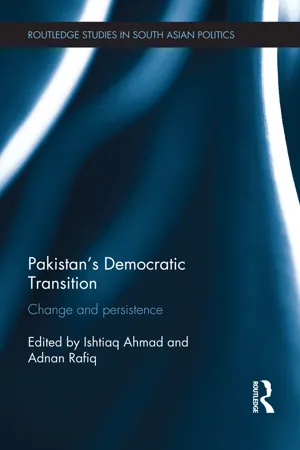Judicial Activism
Judicial activism refers to the tendency of judges to interpret the law in a way that advances their own political or social views, often by expanding the scope of judicial power. This approach is seen as departing from a strict interpretation of the law and can be controversial, as it may be perceived as judges overstepping their role in the legal system.
8 Key excerpts on "Judicial Activism"
- eBook - ePub
The Citizen and the State
Criminal Justice and Civil Liberties in Conflict
- Angus Nurse(Author)
- 2020(Publication Date)
- Emerald Publishing Limited(Publisher)
...Judicial Activism provides that governments are not above the law and for an assessment of whether Government has acted lawfully and has the balance right between criminal justice and human rights. However, even within the UK, where the Human Rights Act 1998 arguably provides for extensive scrutiny of the application of law, the courts cannot overturn legislation. However, as examples discussed throughout this book illustrate, a declaration of incompatibility within the UK's system and findings that government has exceeded its powers elsewhere can be powerful tools to make the executive look again at the exercise of its powers. Conceptions on Judicial Activism, the Citizen and the State Chapter 2 highlighted the importance of the rule of law and the role of the judiciary as upholders of civil liberties in order to enforce the rule of law. Integral to this conception is the role of an independent judiciary with effective scrutiny powers over state exercise of criminal justice powers and with appropriate freedom to uphold human rights, censoring the Executive where required. As this chapter indicates, the principle of separation of powers is essential to effective judicial scrutiny, but so too is the contested notion of Judicial Activism. Judicial Activism is arguably in the eye of the beholder and contrasts expected deference to the policy imperatives of the elected government with unwanted criticism or the expansion of judicial scrutiny into areas of policy. Thus, the ‘activist’ judge is arguably one who seeks to criticise Government policy which infringes on human rights and rules against the Government, upholding human rights over policy imperatives. However, such an activist may simply be implementing international and domestic human rights norms in a manner that protects citizens whilst frustrating the expansion of criminal justice powers...
- eBook - ePub
Courts and Judicial Activism under Crisis Conditions
Policy Making in a Time of Illiberalism and Emergency Constitutionalism
- Martin Belov, Martin Belov(Authors)
- 2021(Publication Date)
- Routledge(Publisher)
...In other words, Judicial Activism refers to the complex of judicial activities through which the judges consciously and explicitly take upon themselves a power that has traditionally been left to other institutional actors, e.g., the political actors sitting in the national assemblies or (to a lesser extent) the public administration. In doing so, the courts are guided by the idea that their primary role is neither to find the true intention of the legislative bodies nor to review the work done by the public agencies. Instead, they intend to act as guardians of the legal system as a whole, by positioning themselves as a third party and solving disputes in the light of fundamental legal principles which have not been contemplated by the legislative bodies and/or which have been neglected in administrative practice. Second, when referring to Constitutional Courts, this includes all the highest courts that – under varying names (e.g., High Council or Supreme Court) – have among their primary legal duties the jurisdiction to evaluate the constitutionality of the law, i.e., the consistency or conflict of legally relevant documents produced within a certain legal system in relation to the basic legal documents of that community. Such courts are also characterised, at least with respect to conducting constitutional reviews, by being positioned outside the ordinary court system, in a sense, and by their work being completely independent (at least in its modality) from the other branches of the state. 6 It is worth noting that several types of Constitutional Courts can find a place under this definitional umbrella...
- eBook - ePub
The United States Supreme Court
A political and legal analysis, second edition
- Robert J. McKeever(Author)
- 2016(Publication Date)
- Manchester University Press(Publisher)
...In fact, in many respects, they exhibited the same characteristics as the liberal activists of the Warren Court in the 1950s and 1960s. Ultimately, whatever the professed motives behind it, Judicial Activism has the result of thrusting the Supreme Court to the centre stage of American politics. In contrast to a restraintist Court, an activist Court will be regularly involved in politics, not simply because it resolves constitutional controversies, but because it resolves them according to its own confident view of what the Constitution demands. The political context of judicial review So far in this chapter, we have examined the ways in which politics infiltrates the Court’s work through the interpretive and role philosophies of the Justices themselves. It is also important to acknowledge, however, that forces exterior to the Court play a part in creating the political dimensions of judicial review. The most important aspect of this is that other political bodies recognise that decisions of the Supreme Court, however arrived at, may have important political consequences. Quite irrespective of whether the Court applies mechanical jurisprudence or non-interpretivism, its decision contributes to or even determines public policy on that matter. Whether it likes it or not, then, the Court is a policy-maker of importance in the American political system. As a result, other political bodies treat the Court as a policy-making institution and try to influence its decisions. We will see in Chapter 5 that the President and the Senate try to control the process of appointing Justices, so as to entrench their own political views on the Court. But beyond this, they also try to influence the Court’s deliberations and decisions on a case-by-case basis. So do interest groups. The President and the Court Apart from his appointive powers, the President is able to exert political influence on the Court through the Department of Justice...
- eBook - ePub
Empirical Legal Analysis
Assessing the performance of legal institutions
- Yun-chien Chang, Yun-chien Chang(Authors)
- 2013(Publication Date)
- Routledge(Publisher)
...L. R EV. 1441 (2004). 2 Kmiec, supra note 1, at 1442. 3 See Bradley C. Canon, Defining the Dimensions of Judicial Activism, 66 J UDICATURE 236 (1983); William P. Marshall, Conservatives and the Seven Sins of Judicial Activism, 73 U. C OLO. L. R EV. 1217 (2002); Ernest A. Young, Judicial Activism and Conservative Politics, 73 U. C OLO. L. R EV. 1139 (2002). Among the various meanings of the terms, scholars include the following: (1) second-guessing the federal political branches or state governments; (2) departing from text and/or history; (3) departing from judicial precedent; (4) issuing broad or “maximalist” holdings rather than narrow or “minimalist” ones; (5) exercising broad remedial powers; and (6) deciding cases according to the judges’ partisan political preferences, see, e.g., Young, id. 1142. 4 See Cass R. Sunstein, R ADICALS IN R OBES 42 (2005); Frank B. Cross & Stefanie A. Lindquist, The Scientific Study of Judicial Activism, 91 M INN. L. R EV. 1752 (2006). 5 See Cross & Lindquist, supra note 4, at 1759. 6 Id. at 1760; see Margit Cohn & Mordechai Kremnitzer, Judicial Activism: A Multidimensional Model, 18 C AN. J. L. & J UR. 333 (2005). 7 See generally, for example, Ruth Gavison, Mordechai Kremnitzer & Yoav Dotan, J UDICIAL A CTIVISM AT THE H IGH C OURT OF J USTICE : FOR AND A GAINST (2000). 8 The High Court of Justice (HCJ) is one of the functions of the Supreme Court of Israel. When a civil or criminal dispute arises in Israel, it normally makes its way into a county court and then—on appeal—to a district court. Only a handful of such cases reach the Supreme Court as a third instance of cassation. The Supreme Court also sits as an appellate court for cases involving serious criminal offenses, or civil disputes where the value of the claim is very high. Such cases are referred directly to a district court and then, on appeal, to the Supreme Court...
- eBook - ePub
American Government
Political Development and Institutional Change
- Cal Jillson(Author)
- 2019(Publication Date)
- Routledge(Publisher)
...Political System Need Judicial Activism to Work? Courts cannot avoid making policy. Every time a court applies an existing law to a new situation or interprets an existing statute in a novel way, it is reshaping and to some extent elaborating the law. Nonetheless, at some stages in American political history the courts have seemed more eager to lead the national policy conversation than at others. These courts—the Marshall Court of the early national period, the laissez faire courts of Fuller, White, and Taft in the late nineteenth and early twentieth centuries, and the Warren Court of the mid-twentieth century are the three most obvious cases—are said to be engaging in Judicial Activism, and their leading members are called activist judges. Activist judges and courts believe that social, economic, and political problems should be addressed and that the courts are one vehicle for doing so. Judicial restraint is the less glamorous view that judges are to follow the lead of the political branches of the government and to avoid policymaking of their own. Judicial Activism and restraint have no natural or logical identity with liberalism or conservatism, big government or small government, active government or passive government. The Marshall Court of the early nineteenth century had a big government, pro-business cast. During the late nineteenth century and the first third of the twentieth century—that is, during the era of laissez faire—Judicial Activism had a decidedly free market, even antigovernment, cast. Judicial restraint during both of these periods was the stance of those who wanted the courts to step aside so that state and national legislatures and executives could legislate to control large and powerful economic entities like corporations, banks, and railroads...
- eBook - ePub
- Thomas M. Keck(Author)
- 2014(Publication Date)
- University of Chicago Press(Publisher)
...Most fundamentally, popular majorities have regularly and repeatedly rejected the proposition that courts should stop protecting rights altogether. Given the clear public support for certain basic principles of individual liberty and equal treatment—and given the obvious centrality of such principles to any reasonable conception of democratic governance—bipartisan Judicial Activism is the best obtainable vision of the judicial role. Nobody will be happy with it because virtually all political actors will regularly face rights-protecting judicial decisions with which they profoundly disagree. But a substantial majority of the public will be able to live with it because all of them will find that the courts regularly protect rights that they hold dear....
- eBook - ePub
- Susanne K. Schmidt, R. Daniel Kelemen, Susanne K. Schmidt, R. Daniel Kelemen(Authors)
- 2014(Publication Date)
- Routledge(Publisher)
...Activism relocated. The self-restraint of the European Court of Justice in its national context Gareth Davies ABSTRACT Most cases involving EU law are decided in national courtrooms without a preliminary reference. The influence of the Court on these cases is often overstated by focusing on headline principles, such as mutual recognition and state liability. However, application of these principles in specific cases is often mediated by open norms such as proportionality, which allow much national court discretion. Whether national judges apply these open norms in a prointegration way determines how far the broader principles directly impact on the national legal system, and on national regulators: these latter will condition their behaviour according to their expectations of the national judiciary, since these are the judges to which they are directly subject. The Court’s role here is important, but limited. It enables and encourages pro-integration national judicial choices, but its case law does not compel them. Claims of activism need to be partly relocated from Luxembourg to national courts. INTRODUCTION The two central elements of the role of the Court of Justice in European integration are the interplay between its judgments and the European Union (EU) political process, and the impact of those judgments on national law, legal systems and regulators. Within scholarship about the latter the degree to which the Court imposes integration in a way that could be described as ‘activist’ has been a recurring question (Arnull 1996; Craig 2011; Hartley 1996; Rasmussen 1986). In answering this, as in more general analysis of the character and influence of the Court, the primary evidence examined has tended to be the substantive principles expressed in its judgments and the consequences that the particular judgments have for the parties and states involved...
- eBook - ePub
Pakistan's Democratic Transition
Change and Persistence
- Ishtiaq Ahmad, Adnan Rafiq, Ishtiaq Ahmad, Adnan Rafiq(Authors)
- 2016(Publication Date)
- Routledge(Publisher)
...The protection of judges and witnesses also needs to be a priority. 50 Judicial backlog A second challenge facing Judicial Activism emanates from within the judiciary. It is a fact that Judicial Activism has thus far remained largely confined to the arena of high politics, failing to make any significant difference in the delivery of justice to the common man. Lower courts remain beset with corruption, massive pendency, and a source of manipulation of litigation to the disadvantage of the aggrieved. Beyond the echelons of power and confines of high politics, the country’s anachronistic legal system is largely lethargic and lackadaisical in dispensing justice – reflected in the heavy pendency of over two million cases in lower courts across the country. Ten-year aggregate data from all the provincial High Courts demonstrates that other than some brief, unsustainable progress, the gap between disposed and newly initiated cases is an ever-widening one – in other words, case backlogs, and hence court delays, are relentlessly on the rise. 51 Precisely because Judicial Activism has failed to trickle down to the masses level, the country continues to seriously lag behind in the rule of law. Unsurprisingly, thus, the World Justice Project’s Rule of Law Index-2014 painted a worrisome picture of Pakistan: Of the 99 countries surveyed for government accountability, crime, fundamental rights and access to justice, Pakistan ranked ninety-sixth. 52 Dispensing justice at the federal or provincial apex of judicial power represents an unprecedented pro-democratic shift in Pakistan’s political order. However, by failing to continue this process down the judicial ladder, the process will inevitably stall and stoke despair. It is, therefore, critical for democratic progress in Pakistan as well as for the supremacy of the rule of law that the Supreme Court pushes for immediate reform of the legal justice system...

